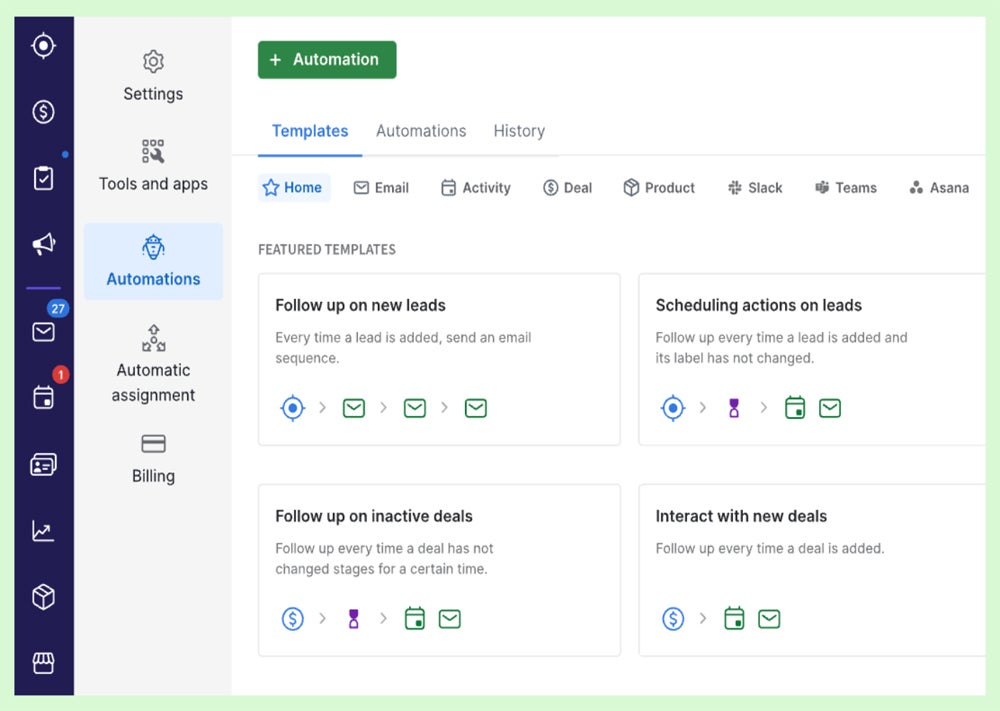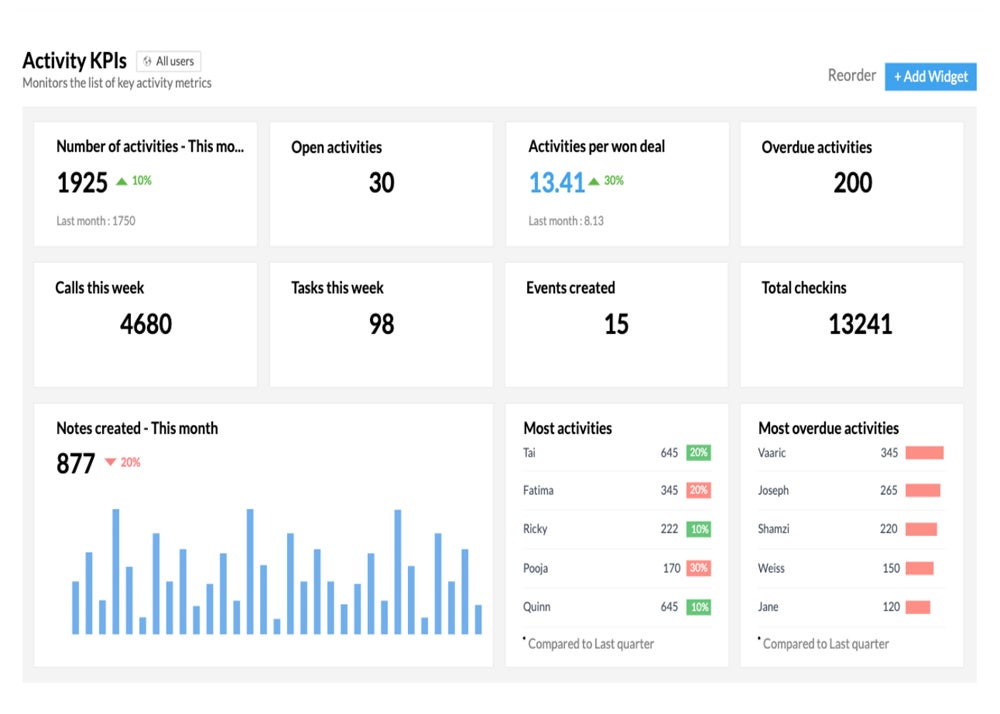Selecting the best CRM software for your business depends on budget, team size, and the features you need to help manage clients through sales processes from beginning to end. Zoho CRM and Pipedrive are both highly rated, scalable platforms because they can do exactly that.
Pipedrive is sales software with a focus on customizable pipelines, activity and contact tracking, and workflow automations. Zoho CRM is a feature-rich CRM with multichannel marketing tools, detailed lead profiles, and team collaboration.
Whether you’re after a marketing- or operations-focused CRM, in a niche industry, or in need of specific sales features, let’s dive into how these two providers stack up against each other.
Pipedrive vs Zoho: Comparison table
| Starting paid plan price | ||
| AI tools | ||
| Free-for-life plan | ||
| Omnichannel communication | ||
| Star rating | ||
Pipedrive vs Zoho: Pricing
Pipedrive
- Essential: $14 per user per month, billed annually, or $24 per user when billed monthly.
- Advanced: $34 per user per month, billed annually, or $44 per user when billed monthly.
- Professional: $49 per user per month, billed annually, or $64 per user when billed monthly.
- Power: $64 per user per month, billed annually, or $79 per user when billed monthly.
- Enterprise: $99 per user per month, billed annually, or $129 per user when billed monthly.
Zoho CRM
- Free CRM: Free for up to three users and comes with lead and document management and a mobile app.
- Standard: $14 per user per month, billed annually, or $20 per user when billed monthly.
- Professional: $23 per user per month, billed annually, or $35 per user when billed monthly.
- Enterprise: $40 per user per month, billed annually, or $50 per user when billed monthly.
- Ultimate: $52 per user per month, billed annually, or $65 per user when billed monthly.
Pipedrive vs Zoho: Feature comparison
AI-powered tools
Winner: Zoho CRM
Zoho CRM offers extensive AI tools, including an AI sales assistant named Zia. Zia can predict sales wins and revenue, detect sales anomalies in real time, and generate emails. These AI tools can run in the background and manage information. More advanced AI features of Zoho CRM include data enrichment, churn predictions, and workflow suggestions.
Pipedrive also has some AI-powered tools that are beta features, though not as extensive as Zoho CRM. Pipedrive’s AI assistant can auto-generate performance tips for sales reps, manage notifications, and provide progress updates on ongoing deals.

Sales automation
Winner: Tie
Sales automations and workflows are popular CRM features because they can take care of redundant or mundane tasks while sales reps are able to focus on other responsibilities.
Zoho’s automation tool can be implemented into lead management by streamlining lead generation and importing data from multiple channels into the CRM. Users of Zoho CRM can build cadence workflows based on customer interactions that incorporate emails, calls, and tasks to create relevant follow-ups and gain the interest of your target customers.
Pipedrive users can automate different steps throughout their sales process. For example, personalized emails can be triggers for engagement once a new contact is entered into the CRM. With Pipedrive’s delay feature, businesses can set up actions to be performed automatically and at their preferred time or date. To do this, just select “predefined” or “custom” preferences to add an action, a condition, or even a delay to your sequence.

Product catalog and invoicing
Winner: Pipedrive
Pipedrive’s invoicing feature can create, view, and send invoices to Quickbooks directly from the Pipedrive interface. After integrating with Quickbooks, users can create invoices that will include pre-configured deal, person, and organization information directly from the detail view. The status of the invoices will then be automatically updated under your deals to keep all information in one central place.
Zoho CRM can integrate with another individual tool in their product suite called Zoho Invoice. This allows users to track and manage key CRM data as well as accounting information in the same place. This way, businesses can generate quotes, invoices, and orders with access to inventory, shipping, and subscription information.

Reporting
Winner: Zoho CRM
Zoho CRM’s report feature can analyze, monitor, and track key business metrics. Users can customize dashboards by choosing from over 40 standard reports or creating a report from scratch. These quick insights can reflect sales, marketing, and general activity reports from multiple modules.
Pipedrive has an insights feature, where users have access to an interactive dashboard. This feature makes it easy to track deals, generate revenue forecasts with deal velocity reports, team performance, share dashboards, and even open APIs and integrations for further customization. All of this helps reps recognize winning patterns so that they can optimize sales workflows and marketing campaigns to see the success they’re after.

Zoho CRM pros and cons
Pros of Zoho CRM
- 15-day free trial.
- Offers over 900 possible integrations.
- Has 24/7/365 data security.
Cons of Zoho CRM
- Limited social media integration available in free plan.
- Users report a learning curve with the platform.
- Users report occasional delays in data loading.
Pipedrive pros and cons
Pros of Pipedrive
- 14-day free trial.
- Users praise easy customization.
- Provides over 400 integrations.
Cons of Pipedrive
- No free-for-life version of the software.
- Users report limited reporting and automations.
- No built-in SMS and reports of a limited mobile app.
Should your organization use Pipedrive or Zoho CRM?
Choose Zoho CRM if . . .
- You need a CRM with advanced marketing capabilities.
- You’re after a CRM solution with a built-in AI assistant.
- You want a powerful CRM tool that has a free plan to try first.
For a more in-depth breakdown of this provider, head over to the Zoho CRM review.
Choose Pipedrive if . . .
- You want a simple CRM for sales pipeline management.
- You’re in a niche industry like architecture, recruitment, nonprofit, or media.
- You need a CRM solution to help segment and assign incoming leads or customers.
Read this Pipedrive review to learn more about its top features and alternatives.
Methodology
I have scored and reviewed Zoho CRM and Pipedrive with an in-house rubric. This rubric includes a variety of criteria and subcriteria deemed important when evaluating any general CRM provider and their business benefits. After running both Zoho CRM and Pipedrive through that rubric, I tabulated a star rating out of 5 as well as key notes that help me identify ideal use cases for each software.
Here’s a breakdown of the scoring criteria I followed:
- Cost: Weighted 25% of the total score.
- Core features: Weighted 25% of the total score.
- Customizations: Weighted 15% of the total score.
- Integrations: Weighted 15% of the total score.
- Ease of use: Weighted 10% of the total score.
- Customer support: Weighted 10% of the total score.
Frequently asked questions (FAQs)
Does Zoho integrate with Pipedrive?
Yes, Zoho and Pipedrive can integrate with one another. Since Zoho Corporation offers a suite of tools in addition to the CRM software, Pipedrive can sync with it as a third-party integration. For example, Pipedrive can integrate with Zoho Books or Zoho Sign. This way, data can be shared between service, sales, and marketing tools.
What kind of companies use Pipedrive?
Companies of any size can adapt Pipedrive as a CRM. Its pricing tiers can account for startups, small-to-midsize companies, and even enterprises. Additionally, Pipedrive can be used by companies in niche markets that might need particular features or compliance certifications, like healthcare, nonprofit, and automotive sales.
Source of Article



